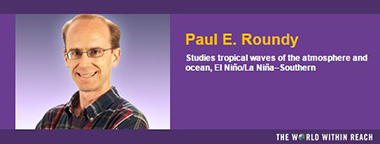Paul Roundy: El Niño Has Played Larger Role than Climate Change in Alberta Wildfires
ALBANY, N.Y. (May 18, 2016) – With this month’s damaging wildfire continuing to wreak havoc in Northern Alberta, there has been a lot of attention paid to what role climate change is playing.
 |
|
Paul Roundy, of the Department of Atmospheric and Environmental Sciences.
|
However, University at Albany climate variability expert Paul Roundy believes a powerful El Niño this year may actually be the larger culprit.
Roundy studied historical weather patterns in the region over recent decades. In the month of April, he found little evidence of significant changes since 1950. April’s weather is important because it sets the stage for May. Low humidity and high temperatures favor a strong potential for fire to occur.
“An absence of a warming and drying trend during April suggests little direct contribution from climate change to this fire event,” said Roundy, who is an associate professor of Atmospheric and Environmental Sciences.
Instead, he thinks a natural variability associated with unusually strong El Niño events enhanced Alberta’s dry warm conditions in May, and generated the wildfire to begin.
“This year’s El Niño event, in particular, spent most of its lifetime in between the central and east Pacific El Niño extremes, favoring a ridge over the Canadian Rockies and Alberta: an ideal scenario for a low snow pack and warm, dry conditions in the spring,” Roundy said.
As for traditional fire season, Roundy has found warmer weather trends during other times of the year, especially June through August. It suggests that climate change is impacting wildfires overall.
Roundy wrote his analysis in the May 16 edition of The Conversation US, an independent source of news and views from the academic and research community. You can read the full piece here: “Why the effects of 2016 El Niño trumped climate change in the Alberta wildfires.”
![]() For more news, subscribe to UAlbany's RSS headline feeds
For more news, subscribe to UAlbany's RSS headline feeds
A comprehensive public research university, the University at Albany-SUNY offers more than 120 undergraduate majors and minors and 125 master's, doctoral and graduate certificate programs. UAlbany is a leader among all New York State colleges and universities in such diverse fields as atmospheric and environmental sciences, business, education, public health,health sciences, criminal justice, emergency preparedness, engineering and applied sciences, informatics, public administration, social welfare and sociology, taught by an extensive roster of faculty experts. It also offers expanded academic and research opportunities for students through an affiliation with Albany Law School. With a curriculum enhanced by 600 study-abroad opportunities, UAlbany launches great careers.


